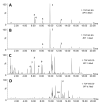In Vitro Sprouted Plantlets of Citrullus colocynthis (L.) Schrad Shown to Possess Interesting Levels of Cucurbitacins and Other Bioactives against Pathogenic Fungi
- PMID: 36297735
- PMCID: PMC9611854
- DOI: 10.3390/plants11202711
In Vitro Sprouted Plantlets of Citrullus colocynthis (L.) Schrad Shown to Possess Interesting Levels of Cucurbitacins and Other Bioactives against Pathogenic Fungi
Abstract
Cucurbitacins, structurally different triterpenes mainly found in the members of Cucurbitaceae, possess a vast pharmacological potential. Genus Cucurbita, Cucumis, and Citrullus are affluent in these bioactive compounds, and, amongst them, Citrullus colocynthis (L.) Schrad. is widely exploited in folk medicine, since a huge number of diseases are successfully treated with organic and aqueous extracts obtained from different organs and tissues of the plant. The well-known pharmacological activities of such species have been attributed to its peculiar composition, which includes cucurbitacins and other bioactive molecules; thus, owing to its high importance as a valuable natural resource for pharmaceuticals and nutraceuticals, C. colocynthis propagation and multiplication protocols are considered significant, but the exploitation of its phytochemical potential is limited by the restricted cultivation conditions and the low rate of seed germination in the natural environment; in fact, the assessment of accumulation rate of specific phytochemicals under controlled conditions is still missing. Axenically sprouted plantlets obtained without the use of culture media or the addition of hormones have been evaluated here for the production of bioactive compounds and relevant bioactive features. Our results proved that derived organic extracts contain cucurbitacins and other bioactives, show antioxidant potential, and exert activity against some pathogenic fungi (Candida krusei, C. albicans, C. parapsilosis, C. glabrata, and Aspergillus flavus), supporting the feasibility of a methodology intended to scale-up cultivation of this species as a source of pharmaceutically interesting compounds, achievable from plantlets cultivated under laboratory conditions.
Keywords: Aspergillus flavus; Candida spp.; Citrullus colocynthis (L.) Schrad; anti-mycotoxigenic activity; antifungal compounds; cucurbitacins; in vitro sprouted plantlets.
Conflict of interest statement
The authors declare no conflict of interest.
Figures





References
-
- WHO Global Centre for Traditional Medicine. [(accessed on 5 May 2022)]. Available online: https://www.who.int/initiatives/who-global-centre-for-traditional-medicine.
-
- Lubbe A., Verpoorte R. Cultivation of medicinal and aromatic plants for specialty industrial materials. Ind. Crops Prod. 2011;34:785–801. doi: 10.1016/j.indcrop.2011.01.019. - DOI
-
- Sudha G., Ravishankar G.A. Involvement and interaction of various signaling compounds on the plant metabolic events during defense response, resistance to stress factors, formation of secondary metabolites and their molecular aspects. Plant Cell Tissue Organ Cult. 2002;71:181–212. doi: 10.1023/A:1020336626361. - DOI
LinkOut - more resources
Full Text Sources
Miscellaneous

